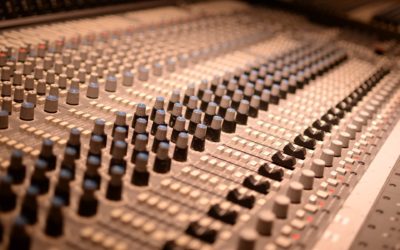Compression is one of the most misunderstood effects for guitarists. It also happens to be one of the most important audio concepts to understand. In this post we’ll clear up the confusion about compression and look at 3 ways to compress your tone without a compression pedal.
Compression Basics
What is compression? Quite simply, compression limits the dynamic range of an audio signal. A compressed signal thus sounds more “even” or “smooth” than an uncompressed signal.
Guitarists have 2 primary uses for compressors. The first is similar to how a mix engineer uses compression – to smooth out levels on a track, or in the guitarist’s case to smooth out levels coming from the amp. A compressor accomplishes this by boosting the softest notes and compressing or “squashing” the loudest notes. This is typically a subtle effect that you wouldn’t necessarily hear until it’s switched off.

The second way guitarists use compression is as a more drastic “squashing” effect, with a lower threshold (the level at which compression kicks in) and a higher compression ratio (which determines how much gain reduction to apply to the signal). Most stompbox compressors exist for this purpose. Think Eric Johnson’s chimey clean tone, Albert Lee’s spanky chicken pickin’ sounds, or David Gilmour’s sweet singing sustain. Or basically any 90s country guitar sound. All this and more made possible by a compression pedal!
While it may not be possible to get classic “squashed” compression pedal tones without a pedal, there are 3 ways that I’ve learned to get more compression out of your guitar rig without a compression pedal. Let’s get to it.
1. The tone control hack
For a natural, studio-like compression effect, roll your guitar’s tone knob back. Rather than setting it and forgetting it at 10, try rolling it back about half way. This will tame the high frequencies that accentuate spiky transients, which in turn makes your playing sound more even and cleaner. If you don’t like the perceived high end loss, compensate with the tone controls on your amp or drive pedals.
2. Crank Your Amp!
Crank your amp! Three words we all love to hear, right? The fact is, the harder you push your amp’s power amp section, the more compressed your tone will be. Guitar amps provide natural compression when they are pushed to the “sweet spot”…that place where the amp comes to life. The sweet spot is different for each amp, but generally it’s at the point where the dynamics of your playing are represented accurately by the amp. In other words, when you play softly the tone is clean, but when you dig in the tone breaks up a bit. This is where you’ll start to hear your amp’s natural compression.
3. Gain Pedals
Gain pedals like overdrive, distortion, fuzz, and boost pedals all add their own compression to your signal. Every gain pedal is different, but as a general rule, the more “drive” you dial in, the more compressed the tone will be.
Stacking gain pedals and making use of your guitar’s volume control will yield great results. This is a hallmark of Michael Landau’s playing. Stack 2 or more gain pedals and use your volume control to dial in the “dirtiness” of your tone. When you roll back the volume the tone will clean up, but the compression coming from the gain pedal(s) will keep your sound full, lively, and present in the mix.
Give these tips a try. You won’t completely eliminate your need for a compression pedal in every scenario, but you will learn how to survive without one!
Did I miss anything? Do you use a compression pedal? I’d love to hear your thoughts!



Thank you! valuable insights!